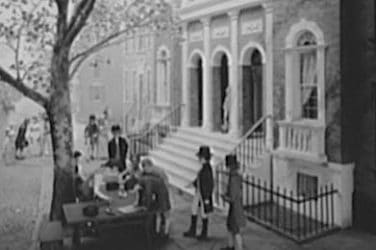Ding ding ding.
That’s the sound of the opening bell at the New York Stock Exchange, which greets millions of people each and every morning either on CNBC, CNN or a multitude of other television networks as well as on the Broad Street trading floor to signify the equities trading markets are officially open. The time is 9:30 EST. It’s time to trade.
But there was a time back when the NYSE when it considered changing its opening time – perhaps moving it back 2 hours – to promote more trading opportunity for investors and help the exchange make more money and grab extra market share. But against the backdrop of protest, the NYSE never changed its opening bell or trading time.
But has it always been that way? And how did the current trade evolve or come to be?

James Angel, Georgetown
No, trading hours weren’t always like this, said James Angel, professor finance at the McDonough School of Business at Georgetown University. In a conversation with Traders Magazine he confirmed that the NYSE’s trading hours have change over time. Current regular trading hours for all major U.S. exchanges have been in place since just 1985.
“They have definitely changed over time,” Angel began. “The NYSE used to be open on Saturdays, but stopped that long ago. Also, during the paperwork crunch of the 1960s they closed early on a number of days to catch up on the volume.”
Looking way back to 1871, NYSE trading hours of continuous trading fluctuated, kicking off at 10 a.m. Eastern Time and ending between 2 and 4 p.m. Monday through Saturday. Then in May 1887, hours change up a bit to 10 a.m. to 3 p.m. Monday through Friday; 10 a.m. to noon, Saturday.
Saturday trading ended in 1952.
While Georgetown’s Angel said he hadn’t heard of any movements to change hours lately, he added that he wouldn’t be surprised if the idea comes back up.
“Now that the exchanges are more highly automated, it is cheap for the exchanges to stay open later,’ he said. “Indeed, many of them keep the computers on until 8pm. However, not much volume takes place after 4pm because most people don’t want to trade outside regular trading hours. However, if regular trading hours were expanded (perhaps to 5pm), there would likely be some additional volume coming in as a response to macro announcements during that time and from retail flow on the west coast. So, the exchanges would see higher total volume at negligible increased cost.”
Spencer Mindlin, capital markets analyst at Aite Group, did tell Traders Magazine that he did know of several proposals to open the market earlier than 9:30am ET during the 1980s and 1990s.

Spencer Mindlin, Aite
“The last time the NYSE adjusted the opening time of continuous trading hours was in the mid-1980s, when it adjusted the open from 10am to 9:30am ET,” Mindlin began. “When NYSE proposed the change in 2005, there was still a relatively vibrant trading floor of specialists and market makers at NYSE, but market share had started to shift onto ECNs, such as Archipelago (not yet acquired by NYSE) and pre-market trading on these electronic trading platforms was starting to gain traction. And at the same time, there was growing interest in trading the U.S. markets by European traders already sitting in their seats and trading non-U.S. markets by the time the 9:30am ET U.S. open came around. Most of pre-market U.S. trading by European traders was then done over-the-counter. So,NYSE CEO Thain figured that by opening up the floor earlier, NYSE would see a boost in liquidity and revenue by attracting traders in Europe, and simultaneously stave off competition from ECNs posing threats to the traditional exchange model.”
But Thain’s proposal faced a lot of opposition, Mindlin said. It was hypothesized that even though European participants might have shown up to trade at 7:30am ET, it was unlikely there would be enough liquidity providers from the U.S. standing ready to trade with sufficiently tight quotes that early in the day. Also, pre-market volumes on ECNs weren’t significant enough to get exchange members excited. And West Coast financial services firms were up in arms about the proposal since they would have had to start their day much earlier and be ready to trade by 4:30am PT, placing them at a competitive disadvantage to firms back East.
“This was not the first time the West Coast firms had to defend against this sort of proposal,” Mindlin said.
But the opposition to changing trading hours, especially the open, also posed technology challenges. Electronic systems at financial services firms need time to recycle and reset, and back-office systems and their personnel rely on the overnight cycle for trade settlement, clearing, reconciliation, and risk evaluation,” Mindlin explained.
“Workers need to go home and sleep. And in the next morning, they arrive ready to resolve trade breaks between 7:30am and 9:30am ET, just in time for traders to start the new day’s trading session with accurate information in their position management systems,” he said.
Furthermore, there are also business and logistical challenges beyond the trading world associated with an earlier open to contend with. Macroeconomic news releases that are typically announced pre-market would have had to move to an earlier window. Listed companies would also have new challenges. If stock-moving news breaks about a company early in the morning, it would require the company’s corporate communications and management teams to get ready to address issues and field investor and press calls well before 7:30am ET. Not to mention it would become especially dicey for CEOs of West Coast and Silicon Valley-headquartered firms who would need to be ready to take press briefings and field investor inquiries well before a 4:30am PT open — one more reason to reconsider going public.
So, what about changes now? So much of life has been moved to a 24/7/365 basis – checking email, being online and other things. So why not trading?
Mindlin said that are at least two significant changes to occur since the 2005 proposal that likely kill any chance the market will any similar proposals.
“Firstly, given the rise in index investing, volume has shifted heavily towards trading into the 4pm ET close,” Mindlin explained. “Much less trading takes place during the intraday session. And secondly, most institutional trading utilizes computer algorithms that try to either achieve a volume-weighted average price over the day or seek out block-sized liquidity and participate without impacting the market. So, by opening the market earlier, the exchange would effectively spread a stock’s volume out over a longer time horizon, making it even harder for traders and their algorithms to be successful and effective.”
Rather than wholesale changes, the market might see some small tweaks – such as how the continuous intraday trading session interacts with the closing auction.
“We hear many traders voice concerns about attempted market manipulation and information leakage during the last twenty minutes of the trading session,” Mindlin said. “This is becoming increasingly relevant as volume gravitates towards the close, fueled by continued shifts towards index investing, daily exposure adjustments for leveraged ETFs, and increased AUM and volume of ETFs and ETF-related trading activity. Some traders we have spoken with advocate for a trading break between the intraday session and the closing auction of between fifteen to thirty minutes. They say the closing auction could take place sometime after the end of the continuous trading session, and such a model would be similar to how many markets operate in Europe.”
With these types of changes, the only participants in the closing auction are those with natural interests. Mindlin said this would greatly reduce the ability of speculators to monitor closing order imbalances and bet on price action into the closing auction (potentially skewing prices in the process). Some may push back on a later start to a closing auction since it will make it more difficult to strike fund net asset values, and back-office resources are dependent upon a 4pm ET (or 4:15pm ET for options and some ETFs) close. To that, some traders propose a commensurate adjustment to the start and end of the continuous trading session so, for example, it opens at 9am and closes at 3:00pm ET. The closing auction would then kick off at 3:30pm. This would give firms breathing room to manage exceptions that often delay net asset value calculations and extra time to prepare for their overnight back-office process.
“There’s another reason to consider such a change,” he added. “It is an antiquated view that market trading hour considerations are a U.S. concern. Consider that the only time the markets are truly closed is the window between the current North American market close and the Asia Pacific open. This poses a problem for global trading firms with APAC trading desks. By the time those APAC markets open, global firms are still a full day behind for position reconciliation and back-office processing. The extra time offered by an earlier U.S. close would result in significant gains in operational and risk efficiency to global trading firms.”
So, traders, what do you think?
This article originally appeared in the March 2005 edition of Traders Magazine
The Downside of an Earlier NYSE Opening
By Gregory Bresiger
Opening the New York Stock Exchange two hours earlier – a proposal under consideration – will not help the buyside, an industry trade group wrote in a letter to the Big Board. “Buyside institutions have only a finite amount of orders in any given day. Extending trading hours will not increase the number of those orders,” wrote John Giesea and James Duncan, president and chairman, respectively, of the Security Traders Association.
“In fact, extending the exchange’s hours could have an adverse impact on liquidity by spreading it out over a longer time span,” according to the STA letter. STA complained that a 7:30 a.m. opening could wreak havoc with West Coast traders. One buyside trading executive said he understood the STA complaints. Still, he sympathized with the potential NYSE move, which would require close SEC attention “The Big Board would not do this by choice. They’re afraid of competition,” said the veteran trader. “Nasdaq,” he added, “is extending their trading time. NYSE is looking at significant liquidity pool pre-opening demands.”
Indeed, at the end of January, Nasdaq sent out several alerts to members about moving up trading hours by late March. “Nasdaq will enhance its pre-market trading capabilities by providing three sessions of pre-market trading for Nasdaq-listed securities,” Nasdaq said. The sessions included one on unlocking/uncrossing a market using similar processes, such as automatic executions and order deliveries to ECNs. In a memo, Nasdaq said that pre-market trading will begin at the end of March, pending SEC approval. “Many traders,” said the trading executive, “are going to trade before the NYSE opens through Nasdaq and ECNs and then just decide to stay there. At least this is what the NYSE is considering.”
Joe Gawronski, chief operating officer with listed and Nasdaq agency brokerage Rosenblatt Securities, said NYSE members would support an earlier opening if Big Board CEO John Thain could justify it as helping business. That’s even though Gawronski has already heard complaints from West Coast clients. Gawronski adds that market share concerns are not an issue for the NYSE’s potential earlier opening.
“Today, ECNs and European exchanges trade miniscule volumes of even the very largest listed stocks prior to the NYSE open, so market share alone doesn’t seem to justify the change,” according to Gawronski.
Steve Austin, an Instinet spokesman, said the firm’s INET ECN records, “a financially insignificant amount of its business in the pre-opening period.” An Archipelago spokeswoman declined comment, saying the company was more interested in its own initiatives. Gawronski said that, unless the market share concerns of the early opening changes, the NYSE will be unlikely to move up its opening by more than a half hour. “We are looking at the issue of an early opening. But the issue hasn’t been decided nor has any time been decided,” said Diana DeSocio, a spokeswoman for the NYSE.






